by Winding Pathways | Jul 8, 2018 | Birds, Garden/Yard, Garden/Yard, Nature
This Nectar is TOOOO Hot! Ahh, Just Right!
Lijun Chadima, Guest blogger
Every year I always like to put the hummingbird feeder out as soon as the weather warms up. It’s been difficult this spring because of the crazy temperature fluctuations. Earlier this spring I was enjoying the warm sunshine on our porch when a beautiful ruby-throated hummingbird flew over and seemed to be wondering, “Where the heck is the feeder?” I boiled the sugar water that afternoon and hung out the feeder the next morning.
Mystery – Why No Hummingbirds?
After a couple days the level of the sugar water in the feeder didn’t appear to go down at all. My little friend stopped by a couple more times, but each time he flew off after just a brief sip. I went out to
check the feeder and discovered it was so hot that I could barely hold it in my hand. No wonder the hummingbirds weren’t drinking any! I suddenly remembered a bird show I saw on PBS that stated hummingbirds try to avoid extreme heat, so that afternoon I took the feeder down from its regular spot which was in direct sunlight, and moved it to a new location where it was in the shade under the sun umbrella.
Mystery Solved!
That apparently did the trick because the very next day multiple hummingbirds took turns drinking from the feeder.
Hummingbirds are a source of endless fascination for me. They are full of energy and dart around the sky in all directions like little helicopters. What a treat when one actually stops to rest on the ledge and enjoy a drink from the feeder. Just remember to keep it in the shade so it’s not too hot for them!
Click on the link below, download and watch the video by Lijun of the hummingbird happily sipping nectar in the shade.
by Winding Pathways | May 31, 2018 | (Sub)Urban Homesteading, Garden/Yard, Garden/Yard
Problem with Hot Weather
A friend emailed today with this dilemma: “I got a whiff of a horrible smell near my rain barrel. I looked inside, and there’s a horrible, putrid layer of something floating on the top of the water. I think it might have come from all the fuzz from the trees in the past few days. Do you think I should empty the barrel, scrub it out, and start over? I do have that screen over the top, but something obviously got through it and seems to be “growing” on top of the water.”
Answer
YES!
Solution

Keep your rain barrels clean in hot weather with these easy tips.
It’s important to do these three things to keep the water fresh:
1. Clean gutters to keep leaves, catkins, and other stuff from getting into the barrel and clean the screen at the top of the barrel.
2. Use the water. Don’t let it stand in the barrel for too long. If it’s really rainy water moves through the barrels and helps keep it fairly fresh.
3. A couple of times during the summer empty the barrel, take the lid off, and wash it out with tap water.
4. Winding Pathways has cleaned the screens on our rain barrels several times already and after each rainstorm. They tend to plug up most during the first few rainstorms. It might also help to put a very small amount of chlorine bleach in the water. It’s toxic to bacteria and molds that might live in the barrel.
A little practical maintenance will make using rain barrels a pleasure and help your plants.
by Winding Pathways | May 24, 2018 | (Sub)Urban Homesteading, Flowers/Grasses, Foraging, Garden/Yard, Garden/Yard, Weeds
Years ago, a homeowner visited a garden store and bought plugs of a plant commercially called ground ivy, but most folks today call it Creeping Charlie.

A great ground cover that can get away from you.
In many ways this exotic plant was an ideal ground cover. It’s tough, easy to transport and plant, adaptable to a wide range of conditions, needs no special care, and it spreads like crazy. It only grows a few inches tall so was touted as a plant that, once established, needs no maintenance. And, it attracts valuable pollinators early in the season before other flowering blooms appear.
Benefits
Creeping Charlie’s benefits are also its curse. It does everything too well. Creeping Charlie doesn’t creep. Rather, it races to cover a yard with astonishing speed, often crowding out more desirable plants.
There are two ways to view Creeping Charlie.
It’s either a pernicious pest or a friend that needs little care. At Winding Pathways, we look at it both ways depending on where it’s growing. When it’s crowding wildflowers or our garden vegetables we rip it out of the ground. In places where it can’t infect a garden or native wildflowers we leave it be and know we won’t need to mow that area often.
Controlling Creeping Charlie
There are lots of ways to control Creeping Charlie. We pull it out of the ground. Roundup and other herbicides kill it, and it’s possible to smother it under black plastic sheeting. Mulch works for a while but soon the plant will thrive on even a thick layer of shredded wood mulch.
A member of the mint family and also known more romantically by an elderly Irish friend as “Gill-Over-the-Ground”, Creeping Charlie is also edible steamed, added to omelets or brewed as a tea.
Other Ground Covers
We prefer ground covers that are less aggressive than Creeping Charlie. One of our favorites is the native Pussy Toes, which grows in patches in our lawn. We planted some when we moved in eight years ago and because we don’t put herbicides on our lawn it is spreading nicely. It is hardy and thrives in dry, sandy soil in baking sun. The hairy, silvery leaves lie close the ground and in spring send up enchanting stems with little “pussy toe” flowers. The Lady Bird Wildflower Center confirms this native plant is widely spread and thrives in open meadows and woodlands and rocky areas. We’ve seen it all over the eastern half of the country and Canada. We love it! Again, it saves mowing, adds color and texture to the landscape and attracts early season pollinators.
We also use Vinca, with its periwinkle flowers, on some parts of our lawn especially areas we do not want to mow. It spreads easily, adds color and texture to the landscape and reduces maintenance.
-
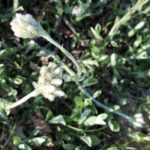
-
Pollinators like ants flock to pussytoes.
-
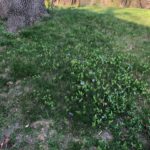
-
An excellent ground cover.
-

-
Pretty purple violets.
Our lawn actually is a mosaic of many plants. Since we shun herbicides we have a lawn blend of grasses, violets, dandelions, pussytoes, and many other plants. They are all fascinating and help pollinators through the seasons.
by Winding Pathways | May 10, 2018 | Garden/Yard, Reflections/Profiles
A Visit to Cheshire Moon Farm
Fans of Alice and Wonderland know the famous Cheshire Cat grin. That feline gave its name to a happy place called Cheshire Moon Farm in rural Atkins, Iowa. Winding Pathways visited in late April and left smiling.
The farm is perched on high ground with a clear view in all directions. “The night sky is gorgeous and the crescent moon reminded me of the Cheshire Cat’s grin, so that’s how our place got its name,” said Elise Gallet de St Aurin.
Happy Animals Reflect Caretakers’ Enthusiasm
The name is appropriate. Elise and her family are caretakers of goats, sheep, horses, guineas, chickens, and a couple of dogs. As she led us around, her cheery enthusiasm was matched by that of the animals. All seemed happy, and if the animals could grin like the Cheshire cat we’re sure they would.
-

-
A great smile
-

-
Elise Holds Goat
-

-
Goats follow Elise around.
-
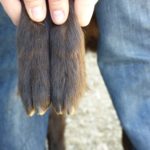
-
Goathooves
Elise holds a master’s degree in agriculture education and chose to return to the family farm after college, where she meshed her considerable energy with enthusiasm and knowledge to build a business centered mostly around goats.
How Goats Help People
There are lots of goats at Cheshire Moon Farm. Some are meat breeds sold for the niche meat market. Other goats are kept for breeding. And, at least one semi-retired animal mentors the herd of younger goats. Still, others are milkers that produce the raw material for the soaps and lotions that Elise makes. Although not approved by the Food and Drug Administration (FDA) for people who suffer from eczema and psoriasis, Elise indicated that some customers find the products helpful.
Thanks to Elise we received a goat education. They are truly amazing and were the first animal domesticated by people some 30,000 years ago in the Middle East. A goat can yield about 45 pounds of meat and a milker may yield up to a gallon a day. Some people enjoy having a goat pet, which has a lifespan similar to that of a dog. Goats live in herds. Sheep in flocks.
There are many goat breeds, and the animals come in many colors and configurations. One goat Elise calls her reverse Dalmatian because of its black body with white spots.
Goats are curious, love to climb on things and are voracious eaters. “They love snacking on woody plants and like poison ivy, Canada thistle, and other prickly plants. In contrast, sheep are grazers that prefer to eat grass,” she said.
-

-
Elise Points
-
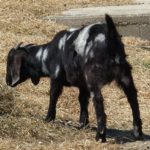
-
Spotted Goat
-
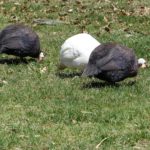
-
Guineas eat ticks.
-
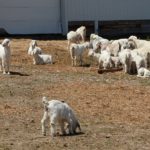
-
All sorts of goats.
Landowners hire her to bring goats to places loaded with exotic undesirable prickly plants. In a short time, the animals devour honeysuckles, barberries, and poison ivy. We asked how she cleans the poison-ivy-eating-goats off. “I mix Dawn soap with water and squirt them down until they turn blue, then hose them off,” she explained.
A Woman on a Mission
In addition to raising goats for brush clearing, milk, and meat Elise, is a farrier who travels to trim the hooves of sheep and goats and had just returned from a Minnesota hoof trimming trip when we met her. She works full time at the Cedar Rapids Tractor Supply Company. Among many duties at the store, she manages baby chick sales.
Despite her vast knowledge of animals, what shines through is her boundless enthusiasm for education, augmented by her master’s degree in that field. She’s also an adept cooperator. “I don’t know machines too well but teamed up with Larry’s Landscaping to fill voids in the farm operation,” she said. While we visited, Larry and two of his children were buzzing around tidying up the property for an upcoming open house.
As we left for home we glanced back at Cheshire Moon Farm. Goats, sheep, chickens, guineas, and horses all seem to give us a big happy grin as if to say, “Hurry back”.
We’ll do that. Anyone is welcome to an Open House from 10 a.m. to 3 p.m. on Saturday, May 19, 2018.
3169 74th St Atkins, IA 52206. 1-319-929-5201.CLG.CONSULTANTS.INC@gmail.com. For information check out CGLHEARTANDHOOVES.COM.
by Winding Pathways | Apr 19, 2018 | Chickens, Garden/Yard, Garden/Yard
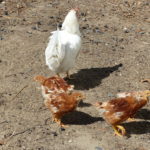
Mama Hen with chicks foraging.
Now a couple of months old, the quartet of chicks is exploring farther afield. After the cold and snowy introduction to the outside world in late March, they readily follow Mama Hen outside.
Mama protects them inside from the other hens by cornering the chicks and standing literally in front of them, screening them from the others who get too close. Outside, Mama clucks and calls the chicks over for food and again, warns off the adults with a serious sounding tone and lunge toward one that may get too close to the chicks or be aggressive toward them.
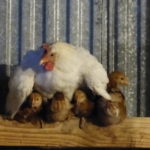
Mama hen with four chicks on roost.
The chicks learned how to fly up onto the roost with Mama and she mightily shelters them at night. We were worried the first few nights in April when temperatures fell to 11 degrees. But, they did OK.
Getting back down off the high perch is a challenge. A hilarious video shows three on the ground foraging and one walking back and forth screwing up courage for the long “flight” down.
The other day, one chick squeezed through the wire into the yard. Mama called it back. The funny thing about chickens is they can figure out how to get out and sometimes cannot figure out how to get back in.
Enjoy our blogs, pix and videos of the chicks growing up.
by Winding Pathways | Mar 17, 2018 | Garden/Yard, Geology/Weather, Mammals, Nature, Wonderment
Don’t Miss March’s Launch of Spring
“If we do not permit the earth to produce beauty and joy
it will in the end not produce food either,” Joseph Wood Krutch.
Too many people miss March’s majesty by staying indoors. After all it’s usually too warm to enjoy cross country skiing or ice fishing and it’s too early to plant the garden, go fishing, or play golf. March is the month of mud, fog, slowly melting grit-encrusted snowbanks, and clammy cold.
At Winding Pathways, we defy normal behavior and spend March days outdoors. It’s the month of great change and nature’s cavalcade is there for any observant person to enjoy.
Just consider the earth and how it’s turning toward our sun. Days lengthen the most around the March 21st Vernal Equinox. This means there is more sunlight each day allowing our yard to soak up more solar energy and spark spring’s revival of life.
March is the month to pull on mud boots and venture outdoors with eyes and ears attuned to the great seasonal change upon us. Here are some things to absorb with great joy:
-
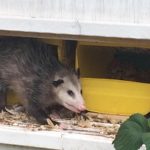
-
“Possum come aknockin’ at the door.”
-

-
Look Up and see skeins of geese winging across the sky
-
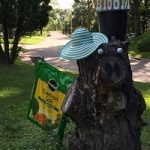
-
Gardening
Birds.
Migration has started. Look up! Way up. Skeins of geese wing high overhead, perhaps so high they are mere specs. Binoculars bring them closer. And their distant and distinct song is music to winter weary ears. Salute their northward journey with a hearty, “Welcome Back!” Many smaller birds are on the prowl, but it may take a close look to notice them. Within a month juncos disappear shortly after red winged blackbirds make their annual debut. Sparrows begin crafting messy nests as goldfinches swap their drab winter outfits for glorious yellow garb. Barred owls fill the night air with haunting cries of WHO COOKS FOR YOU FOR YOU. Sometimes they are in a black oak almost over our roof and startle us awake with their lusty calls.
Mammals.
Even as winter’s song hangs on, baby squirrels are nestling in tree cavities and rapidly growing on a diet of mom’s rich milk. Squirrels are among nature’s most attentive mothers. In another month or two they encourage their babies to venture outdoors. Cottontails begin mating, buck deer begin growing new antlers, chipmunks are increasingly active, and raccoons and opossums prowl the nocturnal yard seeking dinner. On warm misty nights they gorge on nightcrawlers that have emerged on the lawn’s surface to mate.
Plants.
We’re always delighted to find stinging nettles springing out of the still cold earth toward the end of March. There’s no better tasting or nutritious cooked green than a short pile of steaming bright green nettles on the dinner plate. It’s the best time of the year to enjoy tender dandelions leaves in salad. We like the non-bitter blanched leaves discovered under a carpet of oaks. By summer, these leaves are too tough and bitter to enjoy. But, now, they are delicious and nutritious. We can pluck them because we have a spray-free yard.
Spring’s miracle sound.
Sometimes this miraculous sound happens in March but always by early April. Nature’s most promising song comes at vespers each spring, usually in the calendar interval where Easter can fall – March into April. Spring peepers and chorus frogs herald the season each evening. As Christians worldwide celebrate Easter by saying HE IS RISEN, Chorus frogs and peepers enthusiastically seem to announce SPRING IS COMING!
Go Outside! Don’t miss the great vernal seasonal turn. March isn’t a month to huddle by the television. It’s a month to be outside.
-

-
Girls taps a Maple Tree
-
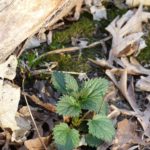
-
Nettles are one of the first greens to poke up through the ground.
-
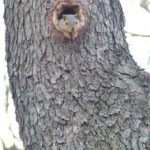
-
Young Squirrel in tree.
-
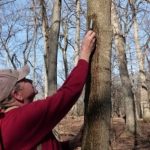
-
Sapsucker holes in tree.
-
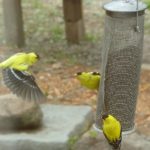
-
Male Goldfinches begin to color up.
-

-
Dark clouds over farmland.
























